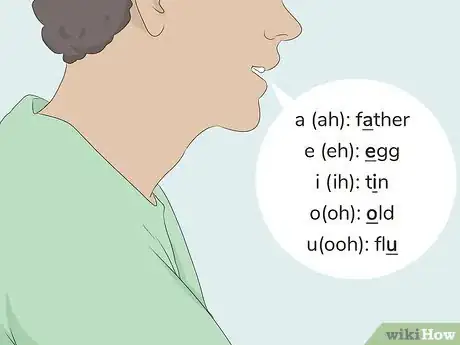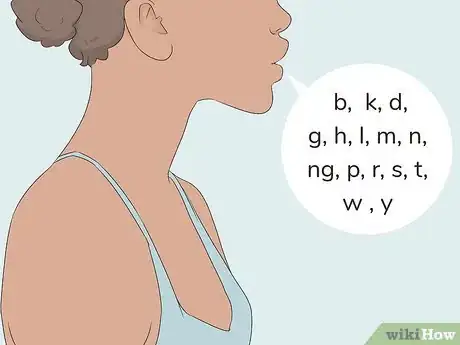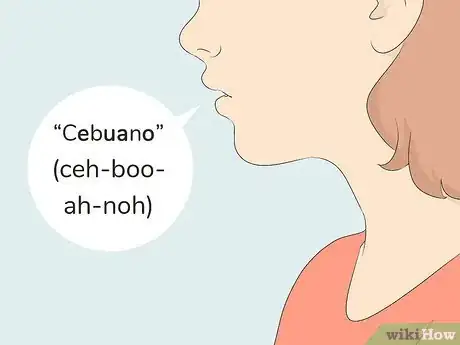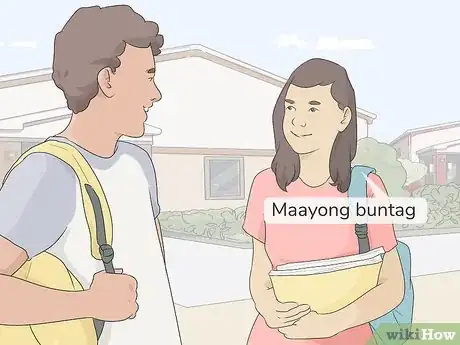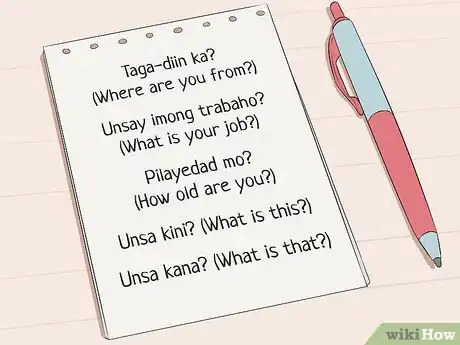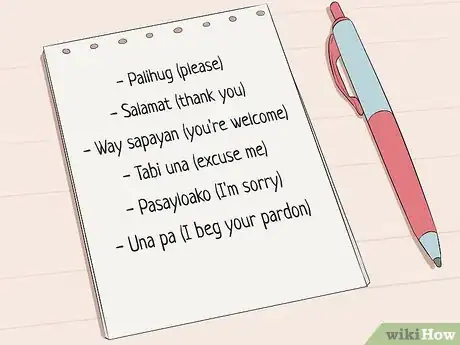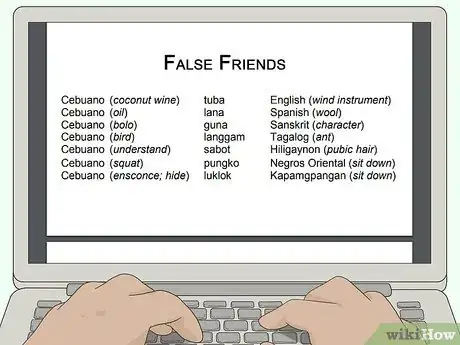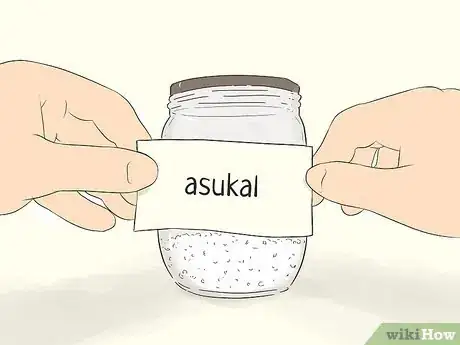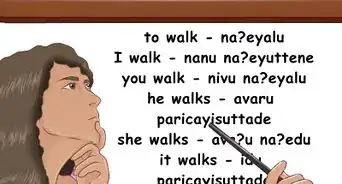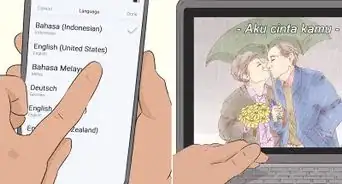This article was co-authored by Tian Zhou and by wikiHow staff writer, Jennifer Mueller, JD. Tian Zhou is a Language Specialist and the Founder of Sishu Mandarin, a Chinese Language School in the New York metropolitan area. Tian holds a Bachelor's Degree in Teaching Chinese as a Foreign Language (CFL) from Sun Yat-sen University and a Master of Arts in Teaching English to Speakers of Other Languages (TESOL) from New York University. Tian also holds a certification in Foreign Language (&ESL) - Mandarin (7-12) from New York State and certifications in Test for English Majors and Putonghua Proficiency Test from The Ministry of Education of the People's Republic of China. He is the host of MandarinPod, an advanced Chinese language learning podcast.
There are 10 references cited in this article, which can be found at the bottom of the page.
This article has been viewed 37,144 times.
Cebuano, named after the island of Cebu in the Philippines, is spoken by about 20 million people in the Philippines, mostly on Cebu but also in other parts of the country. The language is primarily spoken by the Bisaya people, which is why it is also referred to as the Bisaya language. If you want to learn to speak Cebuano, start with pronouncing the alphabet. This will better enable you to sound out words you don't know and understand how to spell words that you hear. Maayong kapalaran! (Good luck!)[1]
Steps
Pronouncing the Cebuano Alphabet
-
1Start by learning the 5 vowels in the Cebuano alphabet. Before the Spanish colonization of the Philippines, Cebuano had only 3 vowels: "a," "i," and "u." However, with Spanish and English influence, "e" and "o" were added. The last 2 vowels are used primarily in words of Spanish or English origin. The 5 vowels make the following sounds:[2]
- The letter "a" has an "ah" sound similar to the "a" in the English word "father."
- The letter "e" has an "eh" sound similar to the "e" in the English word "egg."
- The letter "i" has an "ih" sound similar to the "i" in the English word "tin."
- The letter "o" has an "oh" sound similar to the "o" in the English word "old."
- The letter "u" has an "ooh" sound similar to the "u" in the English word "flu."
Tip: Every vowel in a Cebuano word is pronounced individually; they never blend into one sound. If you see 2 vowels next to each other, as in the word "maayong," they are each separate syllables — mah-ah-yohng.
-
2Say the 15 consonants the same way you would in Spanish. The Cebuano alphabet only has 20 letters — 5 vowels and 15 consonants. The consonants are all pronounced the same way they are in Spanish. The letter "g" only has a hard sound, as in the English word "girl," never a soft sound, as in the English word "general."[3]
- There is one letter in the Cebuano alphabet that doesn't exist in either the Spanish or the English alphabet: the letter "ng." This letter makes a sound similar to the "ng" in the English word "hung," although it's more nasal.
- The 6 letters that exist in the English alphabet but not in the Cebuano alphabet are "j," "c," "q," "v," "x," and "z." However, these letters are used in words of Spanish or English origin (including the "C" in "Cebuano").
- Double "L"s in Cebuano ("ll") make a "y" sound, similar to Spanish.
Advertisement -
3Use vowels to break words into syllables. Every vowel in a Cebuano word is pronounced, and each syllable has only one vowel. Therefore, by looking at the vowels in a Cebuano word, you can figure out the syllables.[4]
- For example, the word "Cebuano" has 4 syllables: ceh-boo-ah-noh. Because native speakers often say their words more quickly, it may sound like "ceh-bwah-noh," but remember — all vowels are pronounced separately.
-
4Place the stress on the correct syllable. In most Cebuano words with more than 2 syllables, the stress is on the next-to-last syllable. In two-syllable words, the stress is typically on the first syllable.[5]
- In some words borrowed from Spanish or English, the stress will be on the last syllable, or on a different syllable, keeping the stress that exists in the origin language. When you see these words written, there will usually be an accent mark (" ´ " or " ` ") over the vowel that's meant to be stressed.
Conversing in Cebuano
-
1Use "hoy" as a general greeting. Many Cebuano speakers simply say "hello." However, "hoy" is a more Cebuano greeting. This is a relatively casual greeting, but is appropriate in all but the most formal settings. If you want to use a more authentic Cebuano greeting, greet people based on the time of day:[6]
- Maayong buntag (good morning)
- Maayong hapon (good afternoon)
- Maayong adlaw diha (good day)
- Maayong gabii (good evening)
Tip: If someone says "maayong buntag" or a similar greeting to you, respond "maayong buntag sab" or "maayong buntag pod." The words "sab" and "pod" are similar to "too" or "also" in English.
-
2Continue your greeting by adding "Kumusta man ka?" This question is a more formal way of saying "How are you?" If you're speaking to a friend or to someone your age or younger, you can simply say "Kumusta ka?"[7]
- The person will likely respond "Maayo, ikaw?" This means "I'm fine, and you?" Respond "Maayo, sab" (Fine, too) or "Maayo, pod" (Fine, also).[8]
-
3Introduce yourself by saying "ang ngalan nako kay" followed by your name. This phrase means "my name is," so it's perfect if you want to introduce yourself and start a conversation. You don't have to worry about "translating" your name into Cebuano — simply pronounce it the way you do in your native language.[9]
- If you want to ask the person their name, follow up with "Kinsay imong ngalan?" You might also use "Kinsay inyong ngalan" if you're speaking to someone older than you or in a position of authority and want to be more formal.
- After the person introduces themselves, you might say "nalipay ko nag nakaila ko nimo," which means "pleased to meet you."
-
4Ask some basic questions to get the conversation going. Even if you don't know a lot of Cebuano, you can still ask some basic questions and get the other person talking. If you don't understand something they said, you can always say "wa ko kasabot" ("I don't understand") or "palihog hinaya pagsulti" ("please speak slowly"). Some good questions to ask include:[10]
- Taga-diin ka? (Where are you from?)
- Unsa imong trabaho? (What is your job?)
- Pilayedad mo? (How old are you?)
- Unsa kini? (What is this?)
- Unsa kana? (What is that?) Say "unsa kadto" to ask "What is that over there?"
-
5Add polite words and phrases to show respect. People will typically be more helpful and forgiving if you're polite, especially if you're just starting to learn their language. Important polite words and phrases in Cebuano include:[11]
- Palihug (please)
- Salamat (thank you)
- Way sapayan (you're welcome)
- Tabi una (excuse me)
- Pasayloako (I'm sorry)
- Una pa (I beg your pardon)
Expanding Your Vocabulary
-
1Pick up words that have Spanish or English origins. There are many words in Cebuano that have been transliterated from Spanish or English and have recognizable meanings as a result. If you speak Spanish or English, you can easily add all of these words to your vocabulary. Just remember to pronounce them using Cebuano phonetics, rather than English or Spanish phonetics.[12]
- Because Cebuano doesn't have a soft "g" or the letter "j," the consonant combination "dy" is often substituted for words of Spanish or English origin that include these sounds or letters. For example, "teenager" in Cebuano is "tinedyer" and "allergy" is "alerdyi."
- The letter "b" is often substituted for "p" or "v" in words of foreign origin. For example, "grabe" for "grave" and "aktibista" for "activista" (Spanish) or "activist" (English).
- The letters "ks" are typically substituted for "cc" or "x" in imported words. For example, the word for "accident" in Cebuano is "aksidente."
-
2Watch out for "false friends." Because Cebuano has so many loan words from Spanish and English, it can be easy to assume that a word that looks familiar has the same meaning in Cebuano as it does in English or Spanish. However, this isn't always the case. Always double-check the Cebuano meaning of a word before you incorporate it into your vocabulary.[13]
- For example, if you hear the word "tuba" in Cebuano, you might think the person is referring to the brass wind instrument. However, in Cebuano, this word means "coconut wine."
-
3Label objects in your home with the Cebuano word. Search the internet for Cebuano vocabulary lists. Write words on sticky notes and attach them to different objects. Each time you pass by the object, say the word aloud. Eventually, you'll come to think of the object first by its Cebuano name, rather than by its name in your native language.[14]
- Start with 5 to 10 objects, then switch to different objects once you've learned those.
- A good list of vocabulary words is available at http://www.bohol.ph/article123.html?sid=ba341e93152dc3758937969cb5ed91f4, adapted from materials prepared for US Peace Corps volunteers.
Tip: You can also use labels to learn words for colors, materials, and directions.
-
4Listen to Cebuano music to improve your pronunciation. Cebu City has a thriving popular music scene, so it should be fairly easy for you to find some music you enjoy listening to with Cebuano lyrics. Because musical lyrics use rhythm and repetition, they make it easy for you to learn the language.[15]
- While you might pick up some language through passive listening, active listening is better. Sing along with the lyrics or print the lyrics off the internet and read along as the song plays.
- You might also try translating the lyrics into your native language. This can improve your understanding of the language.
-
5Travel to the Philippines to immerse yourself in the language. The province of Cebu is a popular tourist destination in the Philippines and the heart of Cebuano. If you have the opportunity, traveling to the area will give you the opportunity to converse with local native speakers and quickly improve your understanding of Cebuano.[16]
- Many people in Cebu, particularly in Cebu City, can speak English rather well. However, if you travel to more rural areas that aren't frequented by tourists, you might find people are more willing to speak to you in Cebuano.
- If people want to talk to you in English or Spanish, feel free to let them know that you would rather speak in Cebuano.
References
- ↑ https://www.wordhippo.com/what-is/the/cebuano-word-for-ff3ddd01b027817c6d90b6fd6a5040a78c805938.html
- ↑ https://nanopdf.com/download/cebuano_pdf
- ↑ https://www.youtube.com/watch?v=oxSKOyi6qWg
- ↑ https://nanopdf.com/download/cebuano_pdf
- ↑ https://nanopdf.com/download/cebuano_pdf
- ↑ https://www.omniglot.com/language/phrases/cebuano.php
- ↑ https://www.omniglot.com/language/phrases/cebuano.php
- ↑ http://www.bohol.ph/article123.html?sid=ba341e93152dc3758937969cb5ed91f4
- ↑ https://www.omniglot.com/language/phrases/cebuano.php
- ↑ http://www.bohol.ph/article123.html?sid=ba341e93152dc3758937969cb5ed91f4
- ↑ http://www.bohol.ph/article123.html?sid=ba341e93152dc3758937969cb5ed91f4
- ↑ https://www.binisaya.com/content/dialectology-cebuano-phonology
- ↑ https://www.binisaya.com/content/spanish-loan-words-cebuano
- ↑ http://www.bohol.ph/article123.html?sid=ba341e93152dc3758937969cb5ed91f4
- ↑ https://blog.esl-languages.com/blog/learn-languages/5-reasons-to-learn-a-language-through-music/
- ↑ https://www.philippinesinsider.com/visayas/helpful-cebuano-phrases-and-words-for-tourists/
- ↑ https://www.omniglot.com/writing/cebuano.htm
